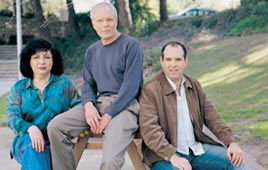According to quantum theory, subatomic particles are characterized by a dual existence, which is influenced by the presence of an "observer", who notices the electrons. What is the difference between people and particles and why is it not possible to send people to the space station?
"The Institute" magazine

In "Nine Princes of Amber" Roger Zilazny tells about the princes of the only real city, who move from point to point in the universe while changing reality with the power of their thoughts. In other words, the world may be predictable, but authority is given. So, for example, the probability that an electron leaving one point will reach a second point depends on whether someone observed it on its way, or measured it in some other way. The observer, according to one of the more well-known principles of quantum theory, changes the result.
Scientists at the Center for Submicron Research at the Weizmann Institute of Science previously demonstrated this principle with electrons. They built an experimental facility the size of a micron (thousandth of a millimeter), which contained a barrier with two openings; Electron beams passed through them, which were launched towards a target board which was placed behind the barrier.
According to quantum theory, subatomic particles are characterized by a dual existence, on the one hand they are particles of matter, but at the same time they are also waves. The waves can simultaneously pass through both openings in the barrier, and then engage each other at any point along the target line. This interference can be constructive - then the electron reaches the point where the interference takes place, or it destroys - then the waves cancel each other, and the electron never reaches this place.
What is a quantum particle?
One of the interesting questions in this context is, "What is a quantum particle" (which can behave as both a particle and a wave). A person, for example, cannot enjoy this coveted status, among other things because his size means that when he moves in the environment, he creates reciprocal relationships with many factors in the environment, which function as "watchers" who deny him the undulating existence and leave him the possibility of material existence only.
If so, where exactly is the boundary between the quantum world and the world of large objects? In different parts of the world, they have already created waves of growing and moving particles, such as "Becky balls", which are structures containing 60 carbon atoms, and even of viruses.
The interference (indicating the passage of waves through both openings in the barrier at the same time) can only occur when there are no observers in the system during its operation. When an "observer" is placed in the system to notice the electrons passing through one of the openings, the picture changes completely: if it is known that the particle passed through one opening, it is clear that it did not pass through the other opening, so that there are no two waves and no entanglement. In that case, the hulk-trons will accumulate behind the two openings through which they passed to the other side of the barrier. This is how the viewer affects the reality he is watching.
Particle statistics
Experiments carried out in the past in this field were, in fact, based on the statistics of many particles that passed through the detector, with each of the "observer" particles acting as an independent and single "observer", providing only a small part of the information of the entire detector. But recently, Prof. Moti Hayblom, research student Yizhar Neder, and Dr. Diana Mahlo and Dr. Vladimir Umansky from the Department of Condensed Matter Physics at the Weizmann Institute of Science, succeeded in building an advanced experimental facility, through which (that is, both the openings in the barrier and the "quantum viewer" ) pass single electrons, one by one.
In fact, the electrons in the viewer were so close to the passing electrons that their presence destroyed the interference. Therefore, when the "watcher" was activated, there was no conflict, and when the "watcher" was not active, there was conflict. When the observer's sensitivity was changed, which also changed the degree of his ability to accurately observe the electron waves passing through the slits of the barrier, a continuous transition from wave behavior to particle behavior was recorded.
After the interference pattern was completely destroyed, and the electrons behaved like particles for everything, the two systems were measured at the same time: the barrier system with the openings and the "quantum observer" system, that is, "the whole world" from the point of view of the electrons. In this measurement, the interference reappeared, which disappeared in the previous measurement, in which only the electrons that passed through the barrier were measured (and as a result of the "observer" measurement, moved to their particle state).
The destruction of the interference and its reappearance is a basic demonstration of the spectator's influence on the outcome. The control of the appearance and disappearance of interference was possible only in a controlled system, with one and only observer. In complex systems, with many observers (such as the reality we all know), the existence of many uncontrolled observers prevents, in fact, the discovery of interference, and therefore causes the constant existence of the particle show. This is one of the reasons why launching and transmitting humans remains - for the time being - the domain of science fiction films.
